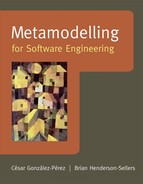REFERENCES
,1. Atkinson, C. 1998. Supporting and applying the UML conceptual framework. In: J. Bézivin & P.-A. Muller (eds). The Unified Modeling Language: Beyond the Notation. LNCS 1618. Berlin: Springer-Verlag. 21–36.
2. Atkinson, C. & Kühne, T. 2000. Meta-level independent modelling. International Workshop on Model Engineering at the 14th European Conference on Object-Oriented Programming. Sophia Antipolis and Cannes, France.
3. Beck, K. 2000. Extreme Programming Explained. Upper Saddle River, NJ: Addison-Wesley.
4. Brinkkemper, S. 1996. Method engineering: engineering of information systems development methods and tools. Inf. Software Technol. 38(4): 275–280.
5. Gogolla, M. & Henderson-Sellers, B. 2002. Analysis of UML stereotypes within the UML metamodel. In: J.-M. Jezequel, H. Hussman & S. Cook (eds). “UML” 2002, The Unified Modeling Language. Berlin: SpringerVerlag. LNCS 2460: 84–99.
6. Gonzalez-Perez, C. & Henderson-Sellers, B. 2005. Templates and resources in software development methodologies. J. Obj. Technol., 4(4): 173–190.
7. Gonzalez-Perez, C. & Henderson-Sellers, B. 2006. A Powertype-Based Metamodelling Framework. Software and Systems Modelling. 5(1): 72–90.
8. Gonzalez-Perez, C. & Henderson-Sellers, B. 2006. An ontology for software development methodologies and endeavours. In: C. Calero, F. Ruiz & M. Piattini (eds). Ontologies in Software Engineering and Software Technology. Springer-Verlag. 123–152.
9. Gonzalez-Perez, C. & Henderson-Sellers, B., 2008, A product pool approach to methodology specification and enactment. J. Systems and Software, 81(8): 1288–1305.
10. Henderson-Sellers, B. 2003. Method engineering for OO system development. Comm. ACM, 46(10): 73–78.
11. Henderson-Sellers, B. & Gonzalez-Perez, C. 2005. The Rationale of Power-type-Based Metamodelling. Second Asia-Pacific Conference on Conceptual Modelling. 30 January to 4 February 2005. Australian Computer Science Communications. Australian Computer Society. 7(6): 7–16.
12. Henderson-Sellers, B. & Gonzalez-Perez, C. 2005. Connecting powertypes and stereotypes. J. Object Technol., 4(7): 83–96.
13. Henderson-Sellers, B. & Gonzalez-Perez, C. 2006. Uses and abuses of the stereotype mechanism in UML1.4 and 2.0 In: O. Nierstrasz, J. Whittle, D. Harel & G. Reggio (eds) Model Driven Engineering Languages and Systems, 9th International Conference, MoDELS 2006, Genoa, Italy, October 2006. LNCS 4199. Berlin: Springer-Verlag. 16–26.
14. Henderson-Sellers, B. & Gonzalez-Perez, C. 2006. On the ease of extending a powertype-based methodology metamodel. Meta-Modelling and Ontologies, Proceedings of the 2nd Workshop on Meta-Modelling, WoMM 2006. LNI. P-96: 11–25.
15. ISO/IEC. 2004. Software Process Assessment – Parti: Concepts and Vocabulary. ISO/IEC 15504-1:2004. Geneva: International Organization for Standardization/International Electrotechnical Commission.
16. ISO/IEC. 2007. ISO/IEC 24744. Software Engineering-Metamodel for Development Methodologies. Geneva: International Organization for Standardization/International Electrotechnical Commission.
17. Kumar, K. & Welke, R.J. 1992. Methodology Engineering: a proposal for situation-specific methodology construction. In: W.W. Cotterman & J.A. Senn (eds). Challenges and Strategies for Research in Systems Development. Chichester, UK: John Wiley & Sons. 257–269.
18. Seidewitz, E. 2003. What Models Mean. IEEE Software. 20(5): 26–31.
19. Standards Australia. 2004. Australian Standard 4651-2004: Standard Metamodel for Software Development Methodologies. Sydney: Standards Australia International Ltd.
20. ter Hofstede, A.H.M. & Verhoef, T.F. 1997. On the feasibility of situational method engineering. Information Systems, 22(6/7): 401–22.
1 The domains (Metamodel, Method and Endeavour) are depicted as horizontal layers. The communities that interact with each domain are indicated by dashed ellipses. The concepts and entities are depicted, respectively, by labelled rectangles and rounded rectangles. Associations are shown as solid non-directed lines; subtyping relationships are shown as solid arrows with a triangular arrowhead; and instantiation relationships are shown as dashed arrows with a simple arrowhead. Resource usages are shown as solid arrows with a simple arrowhead and a small circle at the origin.
2 The material in the remainder of this section plus much of the material in Sections 6.5 and 6.6 was originally published in [8]. It is reproduced here with kind permission of Springer Science and Business Media.
